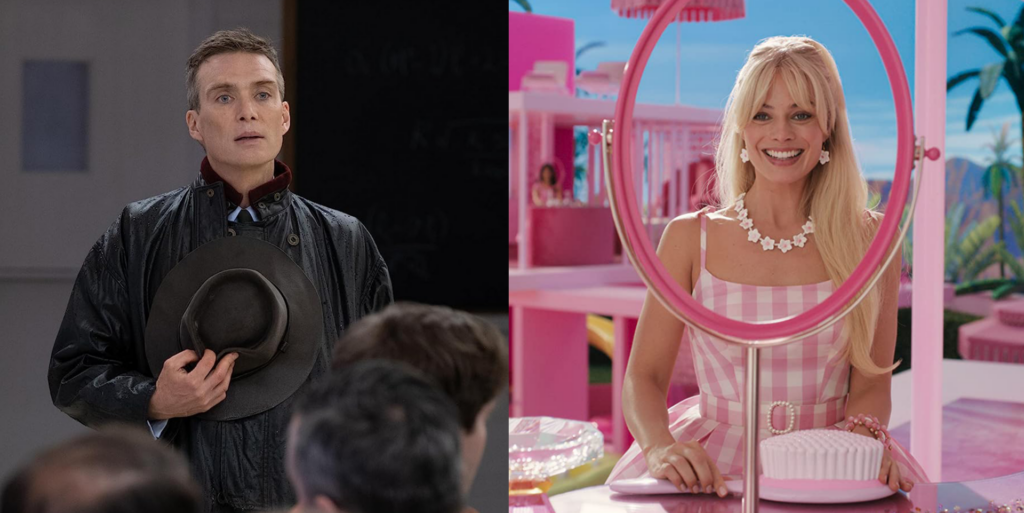What Barbie can teach us about nuclear weapons
By Emily Faux | August 3, 2023
 Photos courtesy of Melinda Sue Gordon/Universal Pictures (Oppenheimer) and Warner Bros. (Barbie)
Photos courtesy of Melinda Sue Gordon/Universal Pictures (Oppenheimer) and Warner Bros. (Barbie)
An unlikely meet-cute took the internet by storm when Greta Gerwig’s Barbie and Christopher Nolan’s Oppenheimer were released on the same day: July 21, 2023.
In the buildup to what became known as “Barbenheimer,” social media filled with commentary on the unlikely pairing. Twitter threads debated the perfect order and schedule for seeing the two films, while memes and TikTok videos played with the apparent radical differences between Barbie hot pink and Oppenheimer ash. The Barbenheimer dichotomy revealed interesting and highly political insights into the popular understanding of nuclear weapons.
Opposites attract. Barbie and Oppenheimer seemed to occupy two extremes. As the director of the Manhattan Project and “father of the bomb,” J. Robert Oppenheimer embodies American hard power: weapons and warfighting capability. A child’s plaything and fictional “it girl,” Barbie embodies American soft power: shaping culture through attraction and appeal.
Barbenheimer is not a joke to everyone. In Japan, where Oppenheimer has not been released, the Barbenheimer mash-up has been criticized for making light of the weapons that destroyed Hiroshima and Nagasaki.
To a scholar of popular culture and nuclear weapons, there are many interesting layers to the Barbenheimer phenomenon. Where memes and TikToks played on points of radical difference—in color, schedule, and subject matter—there were underlying assumptions about nuclear weapons and war to be unpacked.
Because nuclear weapons and war are far removed from public scrutiny and debate, the public comes to learn about these weapons through film, television, and video games.
Barbenheimer memes offer a unique insight into the popular imagination of nuclear weapons and war. Though easily dismissed as frivolous, these memes should be read as deeply political. They are a rare window into the tone, mood, and narrative of nuclear weapons among the next generation. They can reveal what is assumed, what is feared, and what is unknown.
Color contrast. The first point of comparison at the heart of Barbenheimer is color. Many jokes juxtapose or merge the hot pink, associated with the Barbie brand, with black—the color that has come to represent Oppenheimer. Encountering the strange coupling of pink and black feels unsettling and out of place, and many people found humor in highlighting the paradoxical pairing.
Barbenheimer car! pic.twitter.com/4tlVMePprX
— Greg (@gwiss) July 20, 2023
It is notable that black seems to be universally associated with Oppenheimer, given that one could just as easily imagine a fiery red or radioactive green. Perhaps black better connotes the seriousness or morbidity of the Manhattan Project. It suggests a black hole, a black box, a dark pit in public knowledge about nuclear weapons. Neither fire nor radioactivity immediately come to mind. Instead, there is a deep abyss—an absence of the ability to imagine nuclear weapons and war.
The gendering of this comparison will not come as a surprise to most readers. Barbie is stereotyped and marketed as a “girl’s toy,” with Ken dolls and G.I. Joe filling a market gap that allowed boys to play with dolls without risking their masculinity. Nuclear weapons are also starkly gendered in policy discourse, as well as in the media and popular culture. These gendered narratives are reinforced, even exaggerated, by Barbenheimer.
Relying on the juxtaposition of difference, Barbenheimer constructs a clear binary between what is deemed feminine and what is deemed masculine. While one may be welcomed as a Barbie girl in a Barbie world, they would be silenced or shunned in the “real world” of nuclear weapons and war.
Schedule conflicts. As well as color, a second point of comparison was the trend of sharing Barbenheimer viewing schedules online. This trend invited online debates over whether one should watch Barbie and then Oppenheimer, or the reverse. Barbenheimer schedules associated the mood and connotations of different foods, drinks, and activities with each film. For example, “black coffee and Oppenheimer” in the morning, followed by “Barbie and cocktails” to end the day.
people seeing barbie first are wild. the schedule needs to be
black coffee and a cigarette
oppenheimer around 11 (its 3 hours)
mimosas and brunch
barbie around 6/7
dinner, drinks, club https://t.co/oRxWJmE2xm— trish (@ULTRAGLOSS) June 26, 2023
Humor here relies upon strong and shared cultural associations and conventions—for instance, the consensus that black coffee is a strong and serious drink, while cocktails are fun and flippant. Femininity becomes associated with a lack of seriousness and a carefree lifestyle preoccupied with trivial dramas such as dating and fashion. Masculinity is constructed as opposite to and incompatible with femininity, imagined as serious and defined by complex strategy, trade-offs, and moral dilemmas.
While it is funny to play on stark differences, the Barbenheimer memes definitively place nuclear weapons and war in a man’s world. This excuses, and even encourages, women to turn their attention away from these issues.
The gender divide. Having now watched both films, I fear that this gender divide has only become wider. Hailed as a feminist tale of matriarchy and girl power, Barbie challenged and expanded the boundaries of what is deemed feminine. Oppenheimer, true to history, filled laboratories with white men (with brief dialogue encouraging the film’s only female physicist to resign due to the unknown impacts of radiation on the female body). Significant contributions made by women were ignored. Women otherwise appeared as wives and girlfriends, unsurprisingly not passing the Bechdel test—which measures how many women characters are named in a film, and what they talk about.
Barbenheimer. 2023 ✍🏽#Barbie #Oppenheimer pic.twitter.com/aeKpxE1qH9
— JustRalphy (@JustRalphyyy) July 3, 2023
Ultimately, Barbenheimer teaches us that popular culture—starkly and uncritically—defines the nuclear realm as masculine. To be taken seriously in a world of nuclear weapons and war, women must adapt and conform; they must take off those pink heels and wear the black suit.
While it would be wonderful if Oppenheimer renewed public interest in nuclear issues, I would be concerned if this interest came only from a fascination with the hyper-masculine things that go boom.
Together, we make the world safer.
The Bulletin elevates expert voices above the noise. But as an independent nonprofit organization, our operations depend on the support of readers like you. Help us continue to deliver quality journalism that holds leaders accountable. Your support of our work at any level is important. In return, we promise our coverage will be understandable, influential, vigilant, solution-oriented, and fair-minded. Together we can make a difference.
Keywords: Barbenheimer, Barbie, J. Robert Oppenheimer, gender
Topics: Nuclear Weapons, Opinion, Voices of Tomorrow















It’s worth noting that pink only started getting associated with girls after WWII. Without a doubt, Barbie lives in the world that Robert Oppenheimer helped bring about.
I thought the films gad an interlapping metaphor in that Barbie was about smashing the corporate patriarchy and when she storms into the room with the Mattel board of imlacable blacksuited men, it was a metaphor for the Los Alamos all male dominators. working for the most destructive weapons hardly imagineable. Gambling wth the possibility that it could destroy the earth!!
I was also disappointed that the film made no reference to the Polish physicist, Dr. Joseph Rotblatt, who said they should quit making the bomb when they learned Hitler wasn’t about to get it in 1944. He was the only one who did and subsequently won the Nobel Peace Prize in 1995.
Watched both movies twice, all on different evenings. Oppenheimer gives me mild PTSD from life long a-bomb exposure, starting from practicing hiding under my school desk with hands over neck if seeing a bright flash in the window. Still don’t fully understand Barbie. Barbies and Kens both seem to have learned and grown.